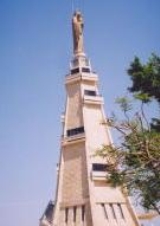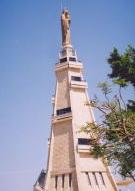
Our Lady of Mantara
Encyclopedia

Maghdouché
Maghdouché is a town in the South Governorate in Lebanon. It is located 50 km south of Beirut and 8 km southeast of Sidon...
in Lebanon
Lebanon
Lebanon , officially the Republic of LebanonRepublic of Lebanon is the most common term used by Lebanese government agencies. The term Lebanese Republic, a literal translation of the official Arabic and French names that is not used in today's world. Arabic is the most common language spoken among...
. The shrine consists of a tower crowned with the statue of the Virgin and Child, a cathedral, a cemetery and a sacred cave believed to be the one where the Virgin Mary rested while she waited for Jesus.
Ancient era
Many historians agree that the devotion to the Virgin Mary in Lebanon replaced the PhoeniciaPhoenicia
Phoenicia , was an ancient civilization in Canaan which covered most of the western, coastal part of the Fertile Crescent. Several major Phoenician cities were built on the coastline of the Mediterranean. It was an enterprising maritime trading culture that spread across the Mediterranean from 1550...
n worship of Astarte
Astarte
Astarte is the Greek name of a goddess known throughout the Eastern Mediterranean from the Bronze Age to Classical times...
. Temples and shrines to Astarte were converted to Christian places of worship, honoring the Virgin. This is also true in Magdhdouché where within the vicinity of Our Lady of Mantara are the remains of a shrine to Astarte.
Middle Ages
During the reign of Emperor Constantine, his mother, Saint Helena of ConstantinopleHelena of Constantinople
Saint Helena also known as Saint Helen, Helena Augusta or Helena of Constantinople was the consort of Emperor Constantius, and the mother of Emperor Constantine I...
, requested in 324 D.C. the destruction of all pagan temples and idols dedicated to Astarte. The Astarte shrine in Magdhdouché was probably destroyed at that time and converted to a place of devotion to the Holy Mother.
Since the early Christian era, the inhabitants of Magdhdouché have venerated the cave where the Virgin Mary rested while she waited for her son, Jesus
Jesus
Jesus of Nazareth , commonly referred to as Jesus Christ or simply as Jesus or Christ, is the central figure of Christianity...
to finish preaching in Sidon
Sidon
Sidon or Saïda is the third-largest city in Lebanon. It is located in the South Governorate of Lebanon, on the Mediterranean coast, about 40 km north of Tyre and 40 km south of the capital Beirut. In Genesis, Sidon is the son of Canaan the grandson of Noah...
. Saint Helena asked the Bishop of Tyre to consecrate a little chapel at the cave in Magdhdouché. She sent the people of Magdhdouché an icon of the Mother and Child and some altar furnishings. Historians believe that Saint Helena asked the people to name the chapel, and they named it “Our Lady of Mantara” or “Our Lady of the Awaiting” because it was there that the Holy Mother waited for her son.
Mantara is derivative of the Semitic root ntr, which means “to wait."
Saint Helena provided funds from the imperial treasury for the maintenance of the chapel. The funding continued for three centuries of Byzantine
Byzantine
Byzantine usually refers to the Roman Empire during the Middle Ages.Byzantine may also refer to:* A citizen of the Byzantine Empire, or native Greek during the Middle Ages...
rule in Phoenicia
Phoenicia
Phoenicia , was an ancient civilization in Canaan which covered most of the western, coastal part of the Fertile Crescent. Several major Phoenician cities were built on the coastline of the Mediterranean. It was an enterprising maritime trading culture that spread across the Mediterranean from 1550...
until Khalid ibn al-Walid defeated Emperor Heraclius at the Battle of the Yarmuk. While the caliphate
Caliphate
The term caliphate, "dominion of a caliph " , refers to the first system of government established in Islam and represented the political unity of the Muslim Ummah...
, Omar, who became ruler of Jerusalem, was a pious and humble man, sparing Christendom's holiest shrines and being tolerant of his Christian subjects, the Arab rulers of the rest of Byzantium
Byzantium
Byzantium was an ancient Greek city, founded by Greek colonists from Megara in 667 BC and named after their king Byzas . The name Byzantium is a Latinization of the original name Byzantion...
were less tolerant of the Christians, especially in the maritime cities of Tyre, Sidon
Sidon
Sidon or Saïda is the third-largest city in Lebanon. It is located in the South Governorate of Lebanon, on the Mediterranean coast, about 40 km north of Tyre and 40 km south of the capital Beirut. In Genesis, Sidon is the son of Canaan the grandson of Noah...
, Beirut
Beirut
Beirut is the capital and largest city of Lebanon, with a population ranging from 1 million to more than 2 million . Located on a peninsula at the midpoint of Lebanon's Mediterranean coastline, it serves as the country's largest and main seaport, and also forms the Beirut Metropolitan...
, Byblos
Byblos
Byblos is the Greek name of the Phoenician city Gebal . It is a Mediterranean city in the Mount Lebanon Governorate of present-day Lebanon under the current Arabic name of Jubayl and was also referred to as Gibelet during the Crusades...
, and Tripoli
Tripoli, Lebanon
Tripoli is the largest city in northern Lebanon and the second-largest city in Lebanon. Situated 85 km north of the capital Beirut, Tripoli is the capital of the North Governorate and the Tripoli District. Geographically located on the east of the Mediterranean, the city's history dates back...
. After the majority of the Sidonians converted to Islam to receive promised privileges and immunities, the people of Magdhdouché withdrew to higher elevation on Mount Lebanon. The caliphate had recognized the Christians of Mount Lebanon as autonomous communities, paying a fixed tax. Before abandoning their village, they concealed the entrance to the cave of Our Lady of Mantara with stones, earth and vines. The people left the village through obscure mountain paths to the strongholds of Christian Lebanon. The legend of Our Lady of Mantara was passed down to the exiled generations of Magdhdouché for one thousand years.
The people of Magdhdouché did not return to their ancestral home despite the arrival of the Crusaders in Sidon. The Crusaders spent most of the12th and 13th centuries in the shadow of Magdhdouché without ever suspecting the sacred cave’s existence even though they built a small fort, called La Franche Garde, within meters of the hidden entrance to the cave.
Modern era
The people of Magdhdouché only returned to their ancestral village during the reign of Lebanon's greatest ruler, the DruzeDruze
The Druze are an esoteric, monotheistic religious community, found primarily in Syria, Lebanon, Israel, and Jordan, which emerged during the 11th century from Ismailism. The Druze have an eclectic set of beliefs that incorporate several elements from Abrahamic religions, Gnosticism, Neoplatonism...
Prince Fakhreddin II (1572-1635). The prince was the most tolerant and enlightened ruler of his day and age. He believed in equality amongst the diverse religious followers of his Lebanon. To demonstrate this equality, he appointed a Maronite Catholic as Prime Minister, a Muslim as Minister of the Interior, a Druze as Army Commander and a Jew as Finance Minister. His princedom was a rare example of non-sectarianism, and it soon became the most prosperous principality in the Ottoman Empire
Ottoman Empire
The Ottoman EmpireIt was usually referred to as the "Ottoman Empire", the "Turkish Empire", the "Ottoman Caliphate" or more commonly "Turkey" by its contemporaries...
.
It was not easy to relocate the sacred cave even though the men of Magdhdouché worked for hundreds of years near the grotto, pulling down the stones of the Crusader fort for building material for their new homes. The cave was finally rediscovered on September 8, 1721 by a young shepherd when one of his goats fell in a well-like opening in the porous limestone. Wanting to save his goat, the shepherd made a rope from vine twigs, tied it to a tree, and descended into the hole, but the rope broke and he fell. When his eyes became accustomed to the darkness of the grotto, the boy saw a soft glimmer of a golden object, which turned out to be Saint Helena’s, icon of the Mother and Child. The boy climbed up the stone walls and ran to the village to tell his discovery.
Pilgrimage site
Ever since the rediscovery, the cave of Our Lady of Mantara has been open to the public. It has become a major pilgrimage site in the Lebanon. The adjacent hilltop where Jesus and Mary had once stood is now Sidon's Greek Catholic cemetery. Grand festivities are held each year on September 8 to commemorate the rediscovery of the sacred cave.Near the sacred cave, the people of Magdhdouché built a cathedral and a modern tower crowned with a bronze statue of the Virgin and Child. The tower offers pilgrims panoramic views of Sidon, the Mediterranean, and the lush hills, valleys and citrus groves of Lebanon.

